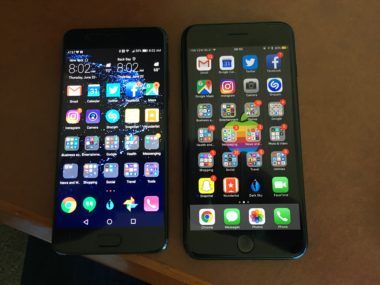Editor’s note: All views, opinions, and reviews in this series are mine and mine alone. I wasn’t paid for my opinion or article, nor was I “urged” to write anything leaning in one direction or another. The phone and watch were given to me by Huawei, however I paid for my own data plan. This review is entirely unbiased.
One of the fun things about having any kind of clout in any industry is that companies occasionally tend to value your opinion. Last year, I entered into a relationship with one such company, Huawei Technology Co. Ltd. Huawei has long been a company unheard of in the United States until very recently, but their footprint overseas continues to grow by leaps and bounds. They’re currently China’s largest non-government owned company, and the third largest handset manufacturer in the world, after Apple and Samsung.
They live in the Android world, a world that up until about 2 years ago, I inhabited as well. Then I moved over to Apple, and have lived on several iPhones since.
Short story: Huawei’s P10+ phone might be the first phone that could possibly convince me to abandon Apple and move back to the Android ecosystem.
After about four hours of making my new P10 look like my old iPhone, (you don’t realize how many apps you use on a daily basis until you’re forced to replicate all of them,) I was ready to use the phone.
Look and feel: It’s a solid phone, designed for those who enjoy the larger end of mobile phones. It’s slightly smaller in size to my iPhone 7+ (6.04 x 2.92 x 0.28in vs. 6.23 x 3.07 x 0.29 in for the iPhone) but not truly noticeable when placed side to side.

Iphone 7+ and the Huawei P10+ side by side
The stats are quite impressive, as well. I’m not going to spend a lot of time on the nitty-gritty tech, as they’re been posted countless times in different outlets. But I’ll say this: The visual appeal of the phone is the screen, and the pure brilliance of the 1440 x 2560 pixels (~540 ppi pixel density) that makes looking at it a pleasure. I don’t know why, but it just seems more “pleasant” than the iPhone 7+. And I thought the iPhone 7+ was stunning when I first got it.
Speed: The P10+ is powered by the Kirin 960 processor from HiSilicon, Huawei’s own chip-making subsidiary. This is important, because as the phone tech evolves, Huawei can simply build new processors specifically for their phones, as opposed to having to bend new phones to the whims of the processors being made.
The phone is faster than my iPhone 7+, but I’m not willing to give that entirely to Huawei yet. It could simply be that I have an uncluttered new phone, that’s not littered with bloatware that comes with every single phone you purchase in the US nowadays. (That being said, my iPhone was purchased unlocked from Apple, so the fact that the P10+ seems faster may be that it’s simply a faster phone with a better operating system. Remember, I was a huge Android fan for years until I converted to iPhone in 2015.
Loading apps such as Facebook or Twitter seem to be faster on the P10+ than on my iPhone, again, that could be because the phone is newer, but either way, it’s slick and super-fast.
The first test: I’m writing this on an Amtrak back from an overnight in Boston, where I decided to take the P10+ and use it as my primary phone, to see if there was anything major the phone couldn’t do that my iPhone could. Short story: The P10+ served me as well if not better than my iPhone over the course of the 24 hour test.
Moving from an ecosystem of fruit to one of robots: My biggest fear, of course, wasn’t the tech of the phone, but moving from one ecosystem to another. Even though 99.9% of my life lives in an ecosystem-agnostic cloud, I was concerned about whether or not I could access whatever I needed when I left the Apple garden for that of Android. There were really only three issues that popped up for me:
The biggest issue I’ve had to deal with so far isn’t actually a fault of Huawei, per se: I currently have my phone on Verizon. The P10+ doesn’t work on Verizon in the United States, not being on Verizon’s “approved devices” list, for some reason. So even though an unlocked P10+ can technically work on VZW’s network, Verizon chooses not to let it. I don’t know if this is a contract thing with Samsung or Apple or whatever, and Verizon’s answer to a tweet asking for info didn’t really answer the question other than confirming that they don’t support the phone. Because of this, I had to keep my iPhone with me at all times during this test, because otherwise I couldn’t answer my multitude of text messages. If I do decide to switch back to Android via Huawei’s P10+, I’d have to leave Verizon and move to another carrier, such as AT&T or Sprint.
I’ll get into the only other issues later, as I recount my day with the P10+
GOAL: Use the P10+ for an entire 24 hour business trip as my primary phone, and look for any issues that would arise from switching ecosystems.
Wakeup: 4:30am. I set the alarm on the P10+ and fell asleep the night before. at 4:30, it woke me up without a problem. It took my sleep-addled brain a few seconds to realize that it was a different phone, and didn’t shut off the normal way.
Workout: I jumped on my Peloton Bike, wearing the Huawei Watch like I would with the Apple watch. I don’t normally count calories on my Apple Watch, preferring to get my calorie count via walking throughout my day, and not including any extra workouts, (it forces me to be more active each day to make my numbers) so I didn’t use the Huawei watch for calorie counting. But, the second I finished my workout, the watch dinged that Strava had recorded the workout, so no difference there.
Since I’m currently in the middle of my longest Apple watch movement streak yet, I had to wear both watches. That’s annoying, but no fault of Huawei, rather of my weird OCD.
Unsure whether the watch was waterproof, I did take it off when I showered, and wondered if the 14 or so calories it wouldn’t record would make that much of a difference in my life.
To the Airport: I was alerted it was time to leave for the airport by Google Calendar, which, since this is an Android phone, was much more embedded in the tech than on my iPhone, where I get a text alert. The embed showed more data, connected to Google Maps, showing ETA and any unexpected traffic. Pinged a Lyft from the phone, and the transition was seamless and easy, with one minor caveat: Logging into Lyft via Facebook, it assumed my old (VZW) phone number, so had I needed to contact the driver, or if I hadn’t found him, he would have called my iPhone. If I were to switch carriers and make the P10+ my primary phone, that issue would disappear.
Arriving at the airport, I used Android Pay to buy my standard “flight M&Ms,” and it worked just as flawlessly as ApplePay. This is a huge win for me, as my life has gotten primarily less “wallet-centric.”
Flight to Boston: The United App worked fine, I got through security, got to the gate, and boarded without a problem. I put the phone on airplane mode when we took off, and it “found” the network and updated my location instantaneously when we landed. It seemed quicker than my iPhone, perhaps it’s a network thing.
To the hotel: When I opened Google Maps to plot out my trip from the airport to the hotel, maps recognized my hotel via my calendar, and suggested it. This is something it doesn’t do on the iPhone, it’s obviously part of the Google ecosystem. That’s a problem with using both at the same time. I live in the Google ecosystem for email, calendar, etc. Because I don’t have an Android phone, however, I miss out on the little things that can happen when everything’s connected, such as suggestions. In this case, it was something minor, but quite cool. Off to the hotel I went. My opinion: It’s these “little things” that can make a person switch ecosystems. The Apple maps application isn’t anywhere near as feature-rich as Google maps, and if I use Gmail, that defines the ecosystem I use. Unless I completely swear off Google, using an Android phone makes more sense, even if just for the little things.
To the gym: Having some time to kill that later that afternoon before my dinner meeting, I headed over to the gym to get a second workout in. It was nice to be able to use my “they can get soaked with sweat and still work” headphones I bought at Radio Shack several years ago again, without having to use the iPhone 7 adapter, as the P10+ still has a headphone jack. Unfortunately, here’s where an issue arose:
My music ecosystem has long been in Apple, for years before I switched over to iPhone. I had an original iPod, and continued updating over and over until I moved to iPhone and didn’t need to. As such, the majority of my music in in the Apple ecosystem.
I’d purchased a $9.95 a month Spotify subscription, and imported my iTunes workout playlist into it. It worked fine on my Mac, but when I opened up Spotify on the P10+, about half my songs were there, but “unable to play on this device.” Upon further research, it would seem that Spotify doesn’t in fact have “everything,” and some songs simply aren’t available on Spotify, but are on iTunes. As such, I had no Hamilton, along with about 100 other songs that are in my iTunes workout mix, but not playable on Spotify.
This is probably the biggest conversion issue for me. It’s not a Huawei problem per se, as it would happen on any Android phone, I assume – The lack of clear transferability. In other words, just because something is in the cloud, doesn’t mean it’s available for the world. Sure, Apple Music is in the cloud. But I’ve purchased that music, and as such, signed their agreement where I understood that I could only use their music in certain circumstances. As such, I’m kind of stuck here. If I can’t find the music on Spotify, then I either have to continue listening to it on Apple, join Apple’s “Apple Music” program for $9.95 a month to use their app on the Android, (and dump Spotify) or live without the several hundred songs I’ve purchased in the past. If there’s a better option, I’ve yet to figure it out.
This isn’t the end of the world, but it’s one of the downsides of going entirely digital – I don’t own CDs anymore. Haven’t in forever. Thus, during an ecosystem change, you could have a few issues like this pop up. I was still able to get my workout done with the songs that Spotify did have, however.
I’m totally kicking X’s ass in my workout count today… Oh, wait, I have no idea if I am: One of the fun things about the Apple Watch is the constant updates you get from people in your circle – People also working out – it’s an added incentive to walk a little more or cycle a little harder, to come out on top of the leaderboard at the end of the day.
While the Huawei Watch is an awesome tool (that comes with its own SIM slot, so you don’t actually need to take the phone with you on runs,) it misses out on some of the community features of the Apple Watch. If I were to make the switch, I’d have to find other people using a Huawei watch, or use RunKeeper, Strava, or Garmin to connect with my friends. Even though I’m only “competing” with four people on my watch, it’s a nice benefit of the watch, one that I lose with an Android ecosystem.
“I’d never date him. He sent me a green text!” I actually overheard this a few years ago, a woman was complaining that she met someone and when texted him, the number was “green,” a sign that he was on an Android, not an iPhone – i.e., not as “cool” in her mind. All I have to say about that is this: The Huawei P10+ is a stellar phone, and much, much better on several levels than the iPhone 7+. If someone doesn’t want to hang with me because of my technology choices, chances are I don’t want to hang with them for many other reasons, anyway.
Finally, the camera on the P10+ is damn impressive. Surprisingly, this is due to the technology in the phone. The Leica camera, and software made from Huawei, Leica, and GoPro truly blow away anything else out there. It’s fun to use, it’s not difficult to learn, and with the “pro” mode, I at times felt like I was shooting with a decent SLR, and not a camera phone.
Huawei has continued with the dual-camera approach it started with the P9, pairing a 12-megapixel sensor with a 20-megapixel monochrome unit, placing both behind f/2.2 lenses. The black-and-white sensor is more light-sensitive, meaning the color image processing pipeline has more data to work with and can theoretically produce higher quality results. Insofar as I can tell, it does.
There’s a great mode I’m calling “Aperture after the fact,” that allows you to change focus in the image long after you’ve shot it. This allows me to take one photo, and if I decide later that the background is more interesting than the foreground, I can easily change it on the fly.
Verdict: I’d switch back to Android tomorrow if I could. The only thing currently holding me from switching from Apple back to Android and the Huawei family of phones is the lack of operability on the Verizon network. It’s my belief, however, that this is a small hurdle, one which will be fixed within the next several months. Once that happens, I see no reason to stick with the iPhone, especially when you consider that our lives are in the cloud already, and Huawei just launched a gorgeous new line of laptops.
In the end, it comes down to the operating system that works for you. For me, since my life is so intertwined with Google, it would only make sense to go back to Android. And the P10, and upcoming Mate 10, are both stellar pieces of technology.

